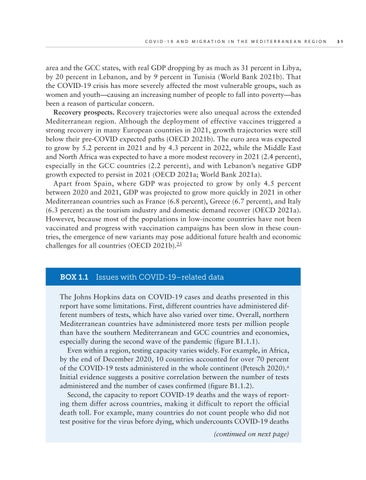C OVID - 1 9 a n d M i g r a t i o n i n t h e M e d i t e r r a n e a n R e g i o n
area and the GCC states, with real GDP dropping by as much as 31 percent in Libya, by 20 percent in Lebanon, and by 9 percent in Tunisia (World Bank 2021b). That the COVID-19 crisis has more severely affected the most vulnerable groups, such as women and youth—causing an increasing number of people to fall into poverty—has been a reason of particular concern. Recovery prospects. Recovery trajectories were also unequal across the extended Mediterranean region. Although the deployment of effective vaccines triggered a strong recovery in many European countries in 2021, growth trajectories were still below their pre-COVID expected paths (OECD 2021b). The euro area was expected to grow by 5.2 percent in 2021 and by 4.3 percent in 2022, while the Middle East and North Africa was expected to have a more modest recovery in 2021 (2.4 percent), especially in the GCC countries (2.2 percent), and with Lebanon’s negative GDP growth expected to persist in 2021 (OECD 2021a; World Bank 2021a). Apart from Spain, where GDP was projected to grow by only 4.5 percent between 2020 and 2021, GDP was projected to grow more quickly in 2021 in other Mediterranean countries such as France (6.8 percent), Greece (6.7 percent), and Italy (6.3 percent) as the tourism industry and domestic demand recover (OECD 2021a). However, because most of the populations in low-income countries have not been vaccinated and progress with vaccination campaigns has been slow in these countries, the emergence of new variants may pose additional future health and economic challenges for all countries (OECD 2021b).23
BOX 1.1 Issues with COVID-19–related data The Johns Hopkins data on COVID-19 cases and deaths presented in this report have some limitations. First, different countries have administered different numbers of tests, which have also varied over time. Overall, northern Mediterranean countries have administered more tests per million people than have the southern Mediterranean and GCC countries and economies, especially during the second wave of the pandemic (figure B1.1.1). Even within a region, testing capacity varies widely. For example, in Africa, by the end of December 2020, 10 countries accounted for over 70 percent of the COVID-19 tests administered in the whole continent (Petesch 2020).a Initial evidence suggests a positive correlation between the number of tests administered and the number of cases confirmed (figure B1.1.2). Second, the capacity to report COVID-19 deaths and the ways of reporting them differ across countries, making it difficult to report the official death toll. For example, many countries do not count people who did not test positive for the virus before dying, which undercounts COVID-19 deaths (continued on next page)
3 1

